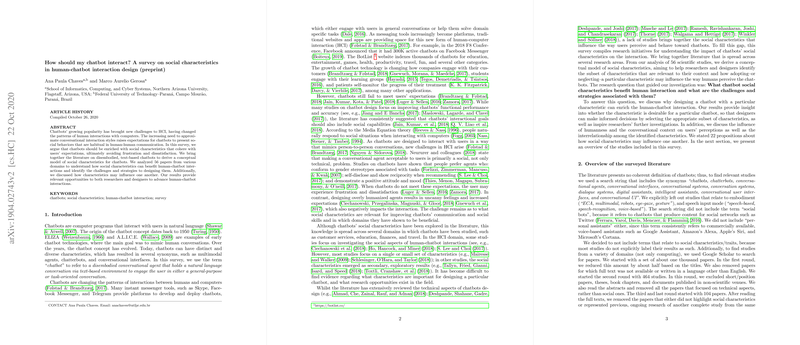Surveying Social Characteristics in Human-Chatbot Interaction Design
The paper "How should my chatbot interact? A survey on social characteristics in human-chatbot interaction design" by Ana Paula Chaves and Marco Aurelio Gerosa provides a comprehensive survey of the various social characteristics that can enhance the interaction between humans and chatbots. The authors synthesize findings from 56 studies, presenting a conceptual model that categorizes social characteristics into three primary domains: conversational intelligence, social intelligence, and personification. This work is pivotal in understanding how chatbots can be designed to meet user expectations for social interaction, thereby minimizing frustration and dissatisfaction.
Key Concepts and Findings
- Conversational Intelligence: This domain focuses on characteristics that enhance a chatbot's role in efficiently managing conversations. The key features include:
- Proactivity: A proactive chatbot can engage users by initiating exchanges, suggesting new topics, or providing additional information. The literature identifies proactivity as beneficial for maintaining user interest and enhancing conversation productivity.
- Conscientiousness: This reflects a chatbot's ability to demonstrate attentiveness to user inputs and the conversational context. Conscientiousness ensures coherence and relevance in responses, reducing user frustration.
- Communicability: Effective communicability allows chatbots to convey their capabilities and limitations to users, addressing discrepancies in user expectations and reducing abandonment.
- Social Intelligence: Social intelligence encompasses chatbots' ability to adhere to social norms and exhibit empathetic behaviors.
- Damage Control: This characteristic is crucial in handling conflicts and failures gracefully, preventing negative escalation in interactions due to user testing or harassment.
- Emotional Intelligence: Though chatbots do not experience emotions, simulating emotional intelligence increases user engagement and satisfaction by fostering a sense of understanding and belonging.
- Manners and Moral Agency: Chatbots should demonstrate politeness and adhere to social ethics to avoid reinforcing negative stereotypes and to create a positive user experience.
- Personification: Personification involves attributing human-like characteristics to chatbots, which can enhance interaction by introducing elements of identity and personality.
- Identity and Personality: These attributes make chatbots relatable and consistent in their interactions. They can enhance user engagement by providing a predictable and enjoyable interaction experience.
Implications and Future Directions
The survey underscores the importance of integrating social characteristics into chatbot design to create more natural and satisfying human-chatbot interactions. By drawing parallels with human social interaction components, the paper provides a framework that aids researchers and designers in identifying relevant characteristics for specific contexts. The findings suggest several areas for further research, including:
- The development of more sophisticated strategies for manifesting emotional intelligence and moral agency in chatbots.
- Evaluating the effectiveness of various social characteristics in different domains and interaction contexts.
- Exploring the intersections of social characteristics, such as how manners can facilitate conscientious communication or how emotional intelligence can enhance communicability.
The prescribed characteristics and their interrelationships provide a foundation for creating chatbots that are not only functionally proficient but also socially adept. This survey acts as a valuable resource for designing chatbots that can meet the nuanced demands of human-social interaction, ultimately impacting the broader field of Human-Computer Interaction (HCI) and paving the way for more sophisticated and user-aligned conversational agents.
